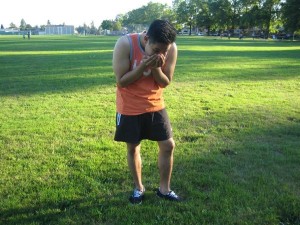Hay fever is a condition where signs and symptoms of a cold show up without the presence of a viral infection. It is due to an allergic reaction instead and affects everyone from time to time in their lives. Allergens such as dust, pollen, animal fur, and etcetera are the common causes.
Hay fever can be a nuisance to everyday life and may hinder or make you perform worse in school or your work environment, but this can be solved by various methods of prevention.
Signs and symptoms of hay fever
- A runny nose
- Sneezing
- Coughing
- Watery, itchy, red eyes
- Itchiness in the nose, mouth or throat
- Fatigue
There are several factors during different seasons throughout the year that may trigger or worsen the signs and symptoms of hay fever.
There are several factors during different seasons throughout the year that may trigger or worsen the signs and symptoms. During the early days of spring, tree pollen is a contributing factor to hay fever. In the late days of spring and summer, pollen from grass can contribute to the signs and symptoms of hay fever. During the fall season, ragweed pollen is a contributing factor. Cockroaches, fur from pets and dust mites are however year-round factors. Fungi, molds, and spoors are also seasonal and year-round factors.
To determine if you have a hay fever or a cold, you can analyze the symptoms that you have.
For hay fever, it can trigger a runny nose with a thin watery drainage and no fever initially. The onset of a hay fever immediately happens after you’ve been exposed to the allergen. The duration of a hay fever lasts until your exposure to the allergens stops.
An appointment with your doctor wouldn’t be necessary until the symptoms start to worsen, but you should immediately see your doctor if:
- You cannot relieve the symptoms of your hay fever
- Medications for allergy does not provide relief or causes unwanted side effects
- You have another existing medical condition that may worsen the symptoms of hay fever
FACT CHECK
https://acaai.org/allergies/types/hay-fever-rhinitis
https://www.medicinenet.com/hay_fever/article.htm
https://www.mayoclinic.org/diseases-conditions/hay-fever/symptoms-causes/syc-20373039

